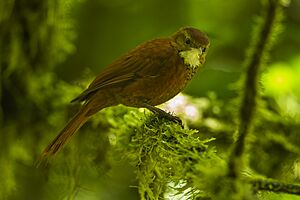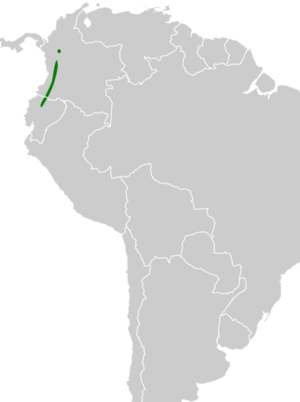Star-chested treerunner facts for kids
Quick facts for kids Star-chested treerunner |
|
|---|---|
 |
|
| Conservation status | |
| Scientific classification | |
| Genus: |
Margarornis
|
| Species: |
stellatus
|
 |
|
The star-chested treerunner or fulvous-dotted treerunner (Margarornis stellatus) is a small bird that lives in Colombia and Ecuador. It belongs to the Furnariidae family, which includes ovenbirds and woodcreepers. This bird is considered a Near Threatened species, meaning it needs our attention to protect it.
Contents
About the Star-Chested Treerunner
This bird is the only species in its group, which means it's quite unique!
What It Looks Like
The star-chested treerunner is about 13 to 15 centimeters (5 to 6 inches) long. It weighs around 21 to 22 grams (about 0.75 ounces). Both male and female birds look the same.
They have a reddish-brown stripe above their eyes. Their cheeks are also reddish-brown. The top of their head is dark reddish-brown, and their back is a bit lighter. Their wings are reddish-brown with darker tips. Their tail is dark reddish-brown and looks a bit spiky at the ends.
Their throat is whitish. The most special part is their chest! It has a reddish-brown background. The upper chest has rows of wide, whitish spots with black edges. Below these, the spots become smaller and more stretched out. These spots fade away towards their belly. Their belly and sides are plain reddish-brown. Their eyes are dark brown. Their beak is horn-colored, and their legs and feet are grayish.
Where It Lives
The star-chested treerunner is found in the Andes mountains of Colombia and Ecuador. In Colombia, it lives in the Western and Central Andes. In Ecuador, it lives in the western parts, going as far south as Pichincha Province. There's also one sighting further south in Chimborazo Province.
This bird likes to live in mountain evergreen forests. It especially loves areas with lots of moss and plants growing on other plants (called epiphytes). In Ecuador, it lives at heights from 1,200 to 1,900 meters (about 3,900 to 6,200 feet) above sea level. In Colombia, it lives a bit higher, from 1,200 to 2,200 meters (about 3,900 to 7,200 feet).
Behavior
Movement
The star-chested treerunner stays in the same area all year long. It does not migrate.
Feeding Habits
This bird eats different kinds of arthropods, which are like insects and spiders. It usually looks for food alone or with one other bird. Often, it joins groups of different bird species feeding together. It searches for food from the middle of the forest all the way up to the treetops.
It's very agile! It climbs up tree trunks and along branches, using its tail to help it balance. It picks bugs off bark, moss, and other plants, sometimes even hanging upside down to get them!
Reproduction
We don't know much about how the star-chested treerunner reproduces. We know their breeding season is at least from February to April. Scientists are still learning about their nests, eggs, and how they raise their young.
Vocalization
You can find recordings of the star-chested treerunner's calls online. However, no one has ever written down a description of what their song sounds like.
Status and Protection
The IUCN (International Union for Conservation of Nature) has listed the star-chested treerunner as Near Threatened. This means it's not in immediate danger of disappearing, but its population might become threatened in the future.
This bird lives in a small area, and we don't know exactly how many there are. However, experts believe their numbers are going down. The biggest threat to them is that their forest homes are being cut down quickly. This happens because of logging, people building homes, cattle grazing, mining, and growing crops like coca and oil palm. These activities are especially harmful in the areas where the treerunner lives.
The star-chested treerunner is common in some parts of Colombia. But in Ecuador, it is very rare and only found in a few places. Luckily, it does live in at least one protected area in Colombia, which helps keep its habitat safe.


